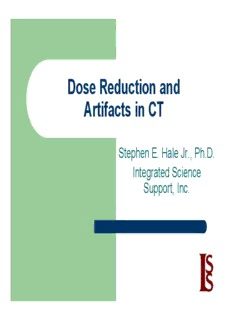
Dose Reduction and Artifacts in CT PDF
Preview Dose Reduction and Artifacts in CT
Dose Reduction and Artifacts in CT Stephen E. Hale Jr., Ph.D. Integrated Science Support, Inc. Outline (cid:1) Nature and History of CT (cid:1) CT Dose Issues (cid:1) Dose Reduction Capabilities (cid:1) Dose Management (cid:1) Artifacts in CT (cid:1) Summary NATURE & HISTORY OF CT First CT - 1967 (cid:1) 1st Generation (cid:1) Translate and Rotate (cid:1) Single detector (cid:1) Hounsfield in 1967 actually had 2 detectors Clinical Introduction (cid:1) First patient head scan performed at Atkinson- Morley Hospital in England on 10/1/1967 (cid:1) 160 rays @ each of 180 angles, 1° apart (cid:1) Scan took 5 minutes (cid:1) Reconstruction took 2.5 hours 2nd Generation CT (cid:1) Still translate and rotate (cid:1) Multiple detectors with multiple beams (or a beam with width = fan beam) (cid:1) Scatter increased with wider beam 3rd Generation CT (cid:1) Widen x-ray beam to a fan beam (cid:1) Array of detectors (cid:1) Physically tie detectors and x-ray source onto same structure (cid:1) Complications – detector stability, matching responses, ring artifacts 4th Generation CT (cid:1) Rotate/Stationary (cid:1) Fixed ring of detectors (cid:1) X-ray tube rotates inside of detector ring (cid:1) Issues Size of system – Cost of detectors – Scatter removal – CT in Motion EBCT – 5th Generation (cid:1) Electron beam onto stationary target with stationary detector array (cid:1) 50 msec imaging times
Description: